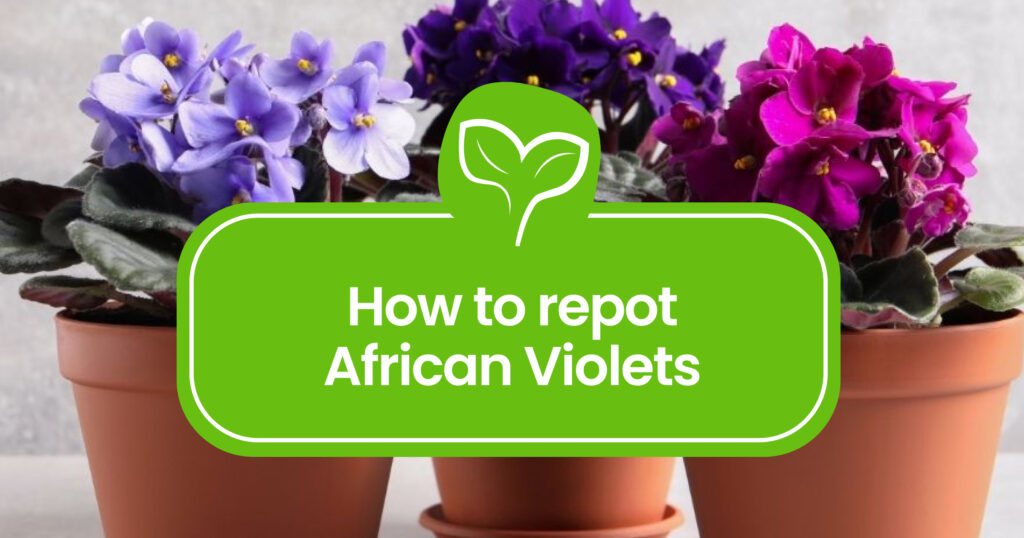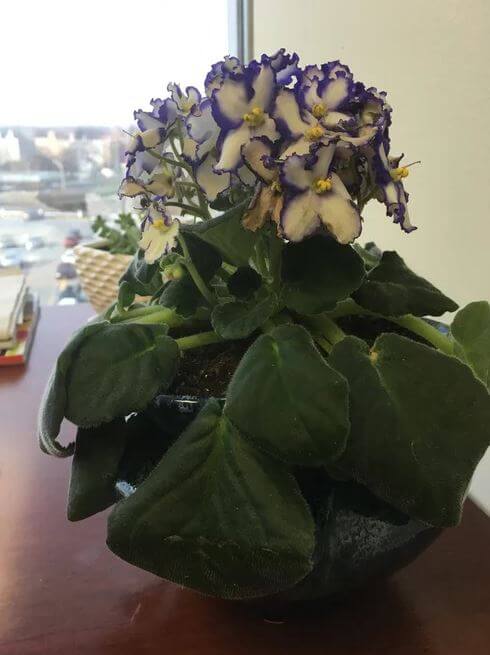
Are your African violets looking a bit lackluster lately? Fear not, because today we’re diving into the ultimate guide on how to repot African violets for some seriously vibrant growth. These delicate beauties deserve the best, so let’s roll up our sleeves and give them the TLC they crave.
We are going to cover:
- How often to repot your African Violets
- How to prepare for repotting
- How to remove your African Violet from its current pot
- How to prune your plant
- What soil you should use for repotting
- How to care for your African Violet after repotting
How Often Should I Repot My African Violets?
First things first, let’s talk timing. Unlike your daily coffee fix, African violets don’t need repotting every morning. Generally, you’ll want to give them some room to stretch their roots every 6 to 12 months. But remember, they’ll give you some telltale signs when they’re feeling a bit cramped – if you spot slowed growth, water not soaking in, or even a stubborn refusal to bloom, it’s probably time to plan a repotting.
Remember, your plant doesn’t always follow your timetable. A long, leafless neck or roots peeking out of drainage holes mean it’s time for repotting, even if it’s not on your usual schedule. Stay flexible to keep your African violet thriving!
How to repot African Violets Step-by-Step
1. Preparations & the tools you need
Start by picking the perfect pot – one that’s just an inch or two bigger than your current one – if your plant is rootbound. In case your African Violet has some difficulties with blooming, you might want to go in the opposite direction and get a pot that is an inch smaller. Gather your repotting essentials:
- fresh soil mix (more on that in a sec)
- a clean pot with drainage holes
- some pruning shears that you’ve just disinfected (pest & disease control is very important!)

2. Remove your plant from its pot
Gently coax your violet out of its old home. It’s like a little plant spa day. If it’s hanging onto the pot hard, a gentle tap on the bottom can help it loosen up. If this does not help, you can use your fingers through the drainage holes to help it out.
If your African Violet sat in a clay pot, giving it a touch of water could ease the process.
3. Tend to the Roots
Alright, let’s get up close and personal with those roots. Gently shake off the old soil and give the roots a little massage to encourage them to relax. Trim away any dead or mushy roots – you’re aiming for those fresh and lively ones. You can also apply some root supplements.
4. Prune your African Violet
Time to give your violet a haircut. Trim any leggy or unruly leaves and satellite sucers to keep things neat and balanced. Don’t be shy – your plant will thank you for its stylish new look. This can help your plant to function more efficiently, saving up some energy.
5. Repot Your African Violet
Place a small layer of fresh soil at the bottom of your new pot. Pop your violet in and fill in around it with more soil, making sure it’s at the same level it was before. Lightly pat it down to give your plant a cozy new home. To make the transition lighter on your plant, put it on a saucer of water and let it soak up as much as it needs. Remember that repotting can be really stressful for plants.
Can you repot an African violet when it’s blooming?
Well, while your violet is showing off its stunning blooms, it’s best to hold off on repotting. Blooming takes a lot of energy, and repotting might stress your plant out a bit too much. So, let it have its spotlight moment, and when the blooms fade, give it that well-deserved repotting TLC.
What is the best soil for an African violet?
Your violet isn’t just a pretty face – it’s quite picky about its soil. Aim for a light, slightly acidic and well-draining mix. You can pick up a specialized African violet mix at your local garden center, or create your own blend by mixing peat moss, perlite, and vermiculite. Think of it as a custom spa treatment for your plant.
Why is my African violet wilting after repotting?
Droopy African violet leaves often result from overwatering, a top culprit. These plants possess delicate roots that dislike waterlogged soil. Too much water for too long can lead to root rot, a serious condition that can endanger your plant’s life.

How do I repot an African violet with a neck?
Ah, the infamous “neck” – when your violet’s leaves seem to emerge from a too-long stem. If your plant has a neck, no worries!
- Snip off the lower 1-2 leaf rings at their base to uncover the neck.
- Gently scrape until the inner green tissue is visible.
- When you repot, bury that neck about an inch deep into the soil. This will encourage new roots to grow along the buried stem, giving your plant a fresh lease on life.
Give it a read

Aftercare
Now that your violet is snug in its new home, give it a gentle drink. But don’t drown it! African violets like their soil slightly damp but not waterlogged. Find a bright, indirect light spot for it to bask in – too much sun could scorch those delicate leaves.
As weeks turn into months, keep an eye out for any signs of discomfort. Adjust your watering routine if needed, and maybe even throw in some diluted, balanced fertilizer every few weeks to keep the party going.
And there you have it, a crash course in African violet repotting that even your green-thumb-challenged cousin could follow. Your violets will reward you with more blooms, lusher leaves, and an all-around happier demeanor. Remember, repotting is like a spa retreat for your plant – it’s all about pampering, patience, and a touch of pruning.
Happy repotting, and may your violets bloom like there’s no tomorrow!
Frequently Asked Questions
Recognizing when your African violet requires repotting is crucial. Here are the steps to become an African Violet repotting pro:
- Long Neck Alert: If your plant’s neck extends significantly, it’s a sign. The leaves might appear distant from the soil, and immediate action is required.
- Root Escape: If roots creep out from the drainage hole and make their way onto the soil, your plant could be getting root-bound. This is a clear indication that repotting is due.
Remember, in these scenarios, don’t wait for your planned schedule – take action for your African violet’s well-being!
Do african violets like to be root bound?
African violets actually like being a bit rootbound. For the right pot size, follow this rule: the container’s diameter should be around one-third of the plant’s leaf span. So, if your violet’s leaves span 12 inches, opt for a 4” pot – that’s the magic number.
To ensure happy roots, use a lightweight soil mix that guarantees proper drainage – it’s like a spa day for your plant.
Do African violets like deep pots?
African Violet roots are more into the horizontal spread, not deep dives. So, when picking a pot, remember they’re not fans of depth – go for a shallower option. Horizontal happiness is their thing!
Can I use regular potting soil for African violets?
Your violet is quite picky about its soil. Aim for a light, slightly acidic and well-draining mix. You can pick up a specialized African violet mix at your local garden center, or create your own blend by mixing peat moss, perlite, and vermiculite. Regular potting soil is not suitable for them.
